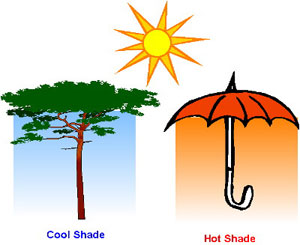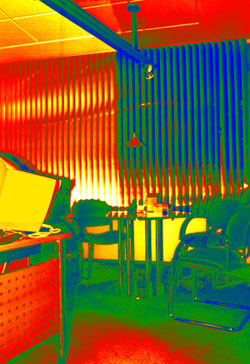Innovative Technologies for Energy Saving and Increase of Thermal Comfort
|
Common solar blind or awning materials are usually a good protection from direct solar light but they do not prevent the room from becoming hot during sunshine hours. Everybody knows the situation: in summer under direct sunlight the shade under a tree is much more comfortable than the shade under a parasol.
The parasol protects from direct sunlight but depending on it’s color the textile becomes warm, and the absorbed heat from the sun will be radiated downwards and create a „hot shade“. The leaves of a tree on the other hand will protect from direct sunlight as well, but different to the parasol they will produce a „cool shade“ as they don’t absorb as much heat from the sun and as additionally the water in the leaves takes the collected heat away. The underside will stay cooler and thus radiate less heat. The new high tech solar blinds and awning materials produce the same effects as the leaves. They absorb less solar energy and radiate less heat than standard materials and thus will create a cooler shade. The physical principle though is quite different:
Due to the low-emissive surface of the underside or room facing side of the new generation materials only 45% of the absorbed heat will be radiated into the room. Standard materials radiate about 95% of their heat into the room, which gives a „hot shade“. The direct sunlight is blocked but the heat still comes in. This thermal image of a typical office situation shows that the new generation solar blinds on the right side are much cooler than those on the left side.
As a consequence the room itself will stay much cooler when it is equipped with the new material. The spectral properties of the new materials (low solar absorption and low thermal emissivity) have been tested by the Bavarian Centre for Applied Energy Research (ZAE Bayern), an institute of high reputation, connected to the Universities of Munich, Erlangen and Wuerzburg. The effects of both sides of the new high tech materials complement each other, which leads to significant changes in the energy flow. The following table shows some test results of the new generation of solar blind material compared to standard solar blinds. Both solar blinds were exposed to 800 W/m² solar radiation.
The test results show that the standard solar blinds still let more than 419 Watts/m² of the solar energy through into the room as heat. With the new solar blinds this decreases significantly to only 86 Watts/m². This is a reduction of nearly 80%. On top of the energy savings in the described summer situation rooms will be kept warmer in winter as well. Now the new materials reflect 55% radiant heating energy back into the room. So heating energy can be saved and thermal comfort is increased. Both the low emissive and the solar reflective side of the new solar blind or awning materials can be manufactured in all desired color tones. Typical applications for the new solar and heat protective materials are solar blinds or awnings but the principle is applicable for tent canvas as well as for sheet metal roofing and other coil coating applications. The combination of solar reflective outside and low emissive underside is highly recommended for the sheet metal roofs of residential and commercial buildings as well as roofing for poultry and pig barns. So everyone will stay cooler in summer and warmer in winter while saving significant amounts of energy at the same time.
|


